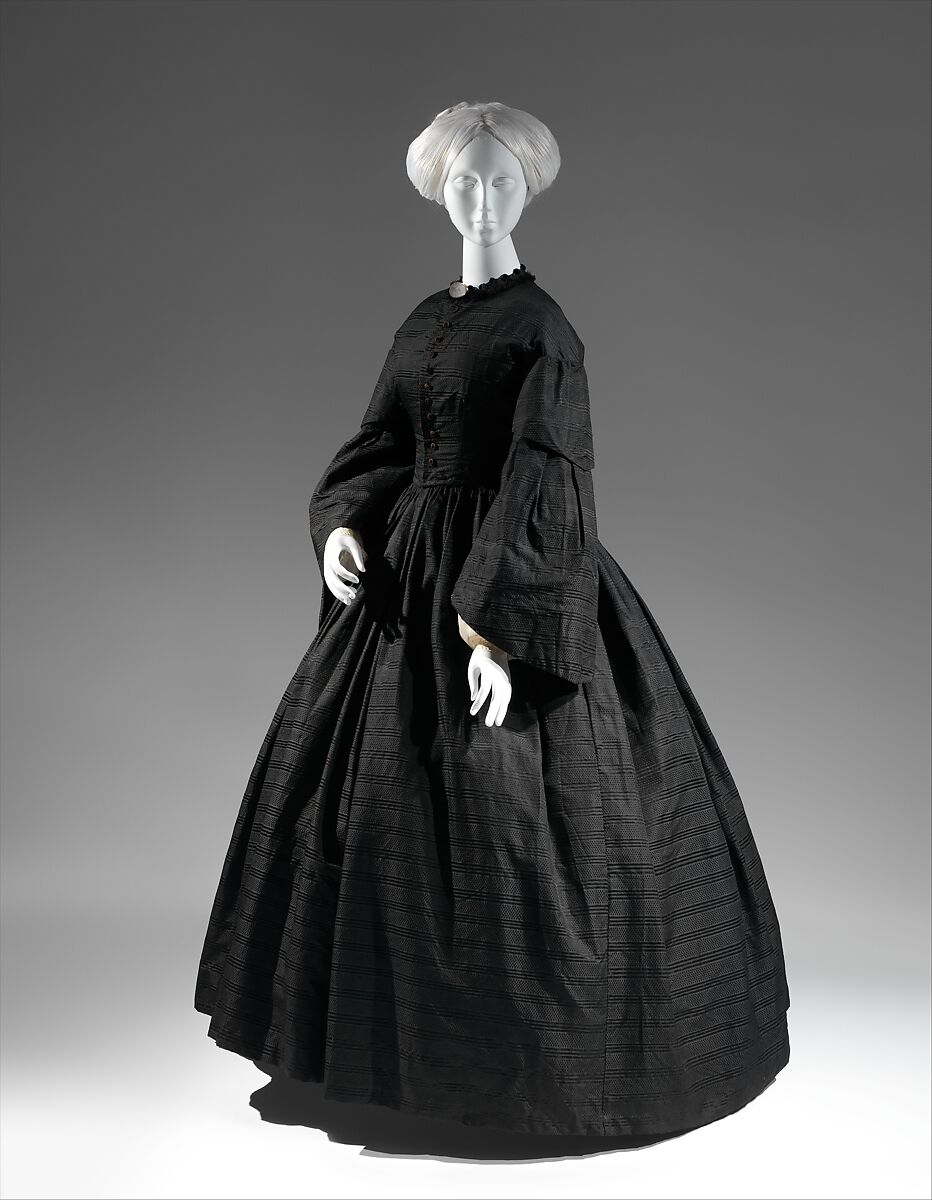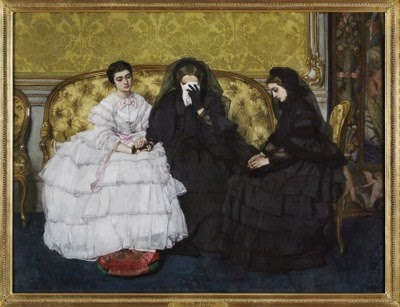This All Soul's Day seemed timely occasion to update and re-publish my 1850s-1860s mourning research. This work was originally posted to the 4th US blog back in 2015. The focus is on European-American mourning practices c.1855-1865, with some earlier/later and foreign sources (primarily British).
***
Given the strongly negative depictions of Victorian mourning practices in modern media (for which I continue to blame Margaret Mitchell), I think it's worth starting any discussion of the topic with this premise: most people mourning a death during the 1850s and 1860s were, in fact, mourning. They might be mourning a close relative or companion, someone they had lived beside for years. They might be paying a token of respect to a distant cousin, a fellow member of an organization, or a benefactor. They might be briefly altering their behavior and dress to show compassion for a friend or neighbor who has experienced a loss. These were real emotions felt by real people, and the mourning rituals of the mid-19th century developed to support them. Our interpretation of mourning as living historians should respect those experiences and the people who had them. Once again, I will link to Betsy's insightful post On Mourning Impressions, which discusses interpreting this topic with delicacy.
At their heart, mourning rituals offer an outlet for grief, allowing the living to express their respect for the dead and their emotions about the loss. As a social custom, mourning attire and practices signal to other people that a death has occurred, allowing them to modify their behavior towards the bereaved. This is known and spelled out in the literature of the mid-19th century:
"The chief use of mourning attire is to express our grief and humiliation, and to remind us of our bereavement on those occasions, when we are liable to be gay and thoughtless. It is also a caution to others, not to converse on light or mirthful topics in our presence; yet we should not speak of death to one who wears a weed."
-George W. Hervey, The Principles of Courtesy (New York, 1856)
As referenced before, people mourn for various reasons and relationships--and so the form that mourning takes also varies. I think this variety is part of the reason why mourning comes across as a complicated and baroque institution. The minute gradations in mourning are perceived as dictating how one is supposed to feel and time limits during which one must display accordingly. I find it more helpful to frame the topic as there being an array of options to express the depth of one's bereavement, as well as a built-in ritual for resuming normal costume and behavior.
 |
| Mourning Dress, 1850s, from the Met |
Duration
There are numerous terms and gradations used to describe nineteenth century mourning attire. As a general rule, they all come down to 1) the darkest and most somber mourning is worn by the people who were closest to the deceased, and 2) those people most severely affected by the loss take some time off of society to mourn, and signify their return to normal activity through gradual changes in dress. Generally speaking, a person who loses a close relative and goes into deepest mourning will begin the process by wearing matte black fabrics (especially crepe/crape and bombazine*), and slowly add in white, more lustrous blacks, and black/white ornaments, then shades of purple and grey, easing back into full colors over time. A less close relative will progress more rapidly through each stage, while distant relations and friends forgo the 'deepest' stages at all.
"Among all civilized modem nations there is a great similarity in mourning customs, and black is universally considered the proper color to be worn, although in the fashions for ladies' dresses modern refinement has gone so far as to symbolize the gradual change from the depth of affliction to a normal state of cheerfulness by a gradual return from black to the gay colors through the intermediate hues of purple and violet, which are recognized as 'second mourning.' The material of a mourning dress is also prescribed by fashion, being for ladies generally crape. The time varies, according to the degree of relationship of the deceased, from a week to a year, the latter being the period fixed by custom for a widow."
-The New American Cyclopedia (1861)
*Both crepe and bombazine are very matte materials with pronounced diagonal patterning. Colored crapes and bombazine were available for general wear, but black crepe and black bombazine were highly associated with mourning, to the point of being iconic. Bombazine is a 2,1-twill woven with a silk warp and wool weft. Crepe is a gauze weave made of raw silk, the twisted threads giving its diagonal pattern effect. Per Textiles in America, wool or wool-silk crepes were also available. The closest modern equivalent, to my knowledge, is a crinkle chiffon, though it needs to be chemically stiffened and cut on the bias to imitate the body of a crepe and its distinctive diagonal lines.
How long one wears the different degrees of mourning varies based on age, gender, relationship to the deceased, means, place of residence, and personal sentiment. Again, generally speaking, the closer the relationship the deeper the mourning; men aren't expected to display their mourning as long or as elaborately as women; poor people will display less than wealthy; and persons who feel strongly may choose to draw out their time in mourning attire (and conversely, people who can wear mourning and do not may be perceived as unfeeling).
The most comprehensive period reference I've found for duration and types of mourning attire is an editorial in Godey's from September 1854. This article emphasizes the need for one's own sentiments to dictate the terms of mourning apparel, and suggests that white be worn both to mourn children and by children in mourning. Though condemning codified mourning, it give as an example "one year for a parent, husband, brother, sister, or child. Six months for grandparents, uncles, or aunts. Three months or six weeks as a token of respect to the memory of a cousin, friend, or remote relative, or anyone who leaves the wearer a legacy." Beyond this article's emphasis on sentiment, the same issue of the magazine features a lampoon of these sorts of codifications in mourning.
The Workwoman's Guide (London, 1838/40) is another which lists time ranges for wearing mourning clothes: 1-2 years for a spouse, 6 months to 1 year for a parent or a child over 10 (3-6 months for a younger child, and 6 weeks or more for an infant), 6-8 months for a sibling, 3-6 months for an aunt or uncle, six weeks to 3 months for a cousin or an aunt/uncle by marriage, and three weeks or more for friends and more distant relatives. Thirty years later, The Art of Dressing Well (1870) would concur on the upper end of this scale. It specifies that widows should wear mourning for two years (one year in deepest black, half a year in less severe black, and half a year in grays/purples). It goes on to explain that mourning is worn for one year for parents and children; six months for grandparents, siblings, and friends who left bequests; and three months for aunts, uncles, nephews and nieces. The last is done in second mourning only (white, black, grays and purples); for the rest, half of the mourning period is spent in the deepest blacks, then a quarter in black/white, and the last quarter with greys and purples.
The Principals of Courtesy (1856) differentiates between widows wearing mourning attire for 1 year and 6 weeks after the death of a spouse, while widowers do so for only 6 months. In either case, the mourning period ends early if the survivor remarries--though the second wedding should be more somber than the first was. As previously noted, The New American Cyclopedia (1861) assumes widows will wear mourning for one year. The one thing all of these sources agree on is that the longest duration of mourning is the widow's.
For public figures, or classmates, or fellow members of clubs, mourning badges might be adopted for a short time. These may be devices made of crepe or simple armbands, generally worn on the left. They are also used for official purposes: worn by soldiers on parade at funerals, or public servants following the death of a president. In some public instances, as for royalty, slight mourning may be worn widely; "court mourning", for those attending on the royal family, can be highly formalized
 |
La Consolation ou La visite de condoléances, by Alfred Stevens, 1857
(Consolation or The Visit of Condolence) Musée d'Ixelles |
Activities
A defining feature of mourning is the lack of social activities. Men must still go to work, but women are granted a sort of 'bereavement leave' from society and hosting. Balls, dinner parties, and amusements are right out...with some exceptions. In lieu of the usual social visits, friends and associates make visits of condolence to the grieving household. Who exactly attends the funeral is a slightly controversial subject, which varies over time and locale.
The Principles of Courtesy (1856) specifies that visits of condolence, made in the week after the funeral, should be short, somber, and sensitive to the bereaved. The Young Lady's Friend (1857) concurs, stressing the need for sympathy and compassion, and the difficult line between not distressing the bereaved further, and not being too cheerful. The Habits of Good Society (1859) deplores these visits, but concurs about the time frame and the difficulty in making appropriate conversation. Etiquette, Social Ethics, and the Courtesies of Society (1854) recommends the visitor on such an occasion wear "black silk, or plain-coloured apparel" to show sympathy with the family; it also advises that 'slight acquaintances' make their visits of condolence after the family has resumed attending church services.
The Art of Dressing Well (1870) advises that "Ladies invited to funeral ceremonies should always wear a black dress, even if they are not in mourning, and it is bad taste to appear with a gay bonnet or shawl, as if it were a festive occasion." This supports the attendance of women at funerals by 1870, though I've found fewer solid descriptions from the 1850s-1860s for what these women were wearing. The Principles of Courtesy (1856) confirms that female relatives and non-relatives attended funerals. Contrary to the above, The Hand-Book of Etiquette (1860) claims that "according to modern etiquette, ladies do not attend funerals", which are "too mournfully exciting" for them. This is qualified with the acknowledgement that some women "brave the excess of grief", and goes on to describe female relatives (both gentry and working-class) wearing black hoods and capes when they do attend funerals. The former, apparently, only rarely attend funerals, while working class women are said to do so regularly. An account of British nurses in the Crimean war mention the female nurses attending a colleague's funeral in their "black capes and hoods", some even acting as pall-bearers.
[To be continued in Part II: Mourning practices in contemporary literature and fashion magazines.]



























